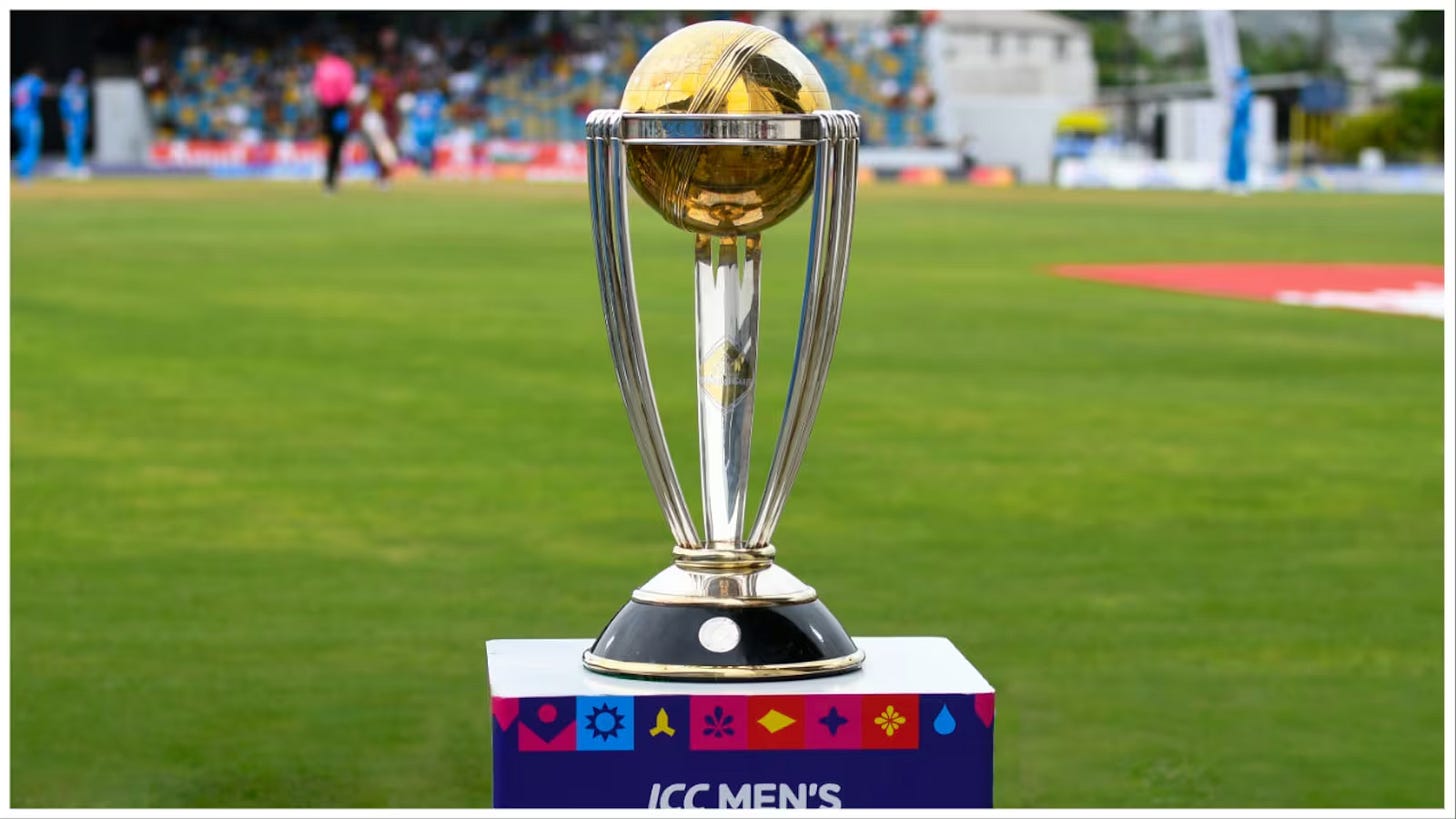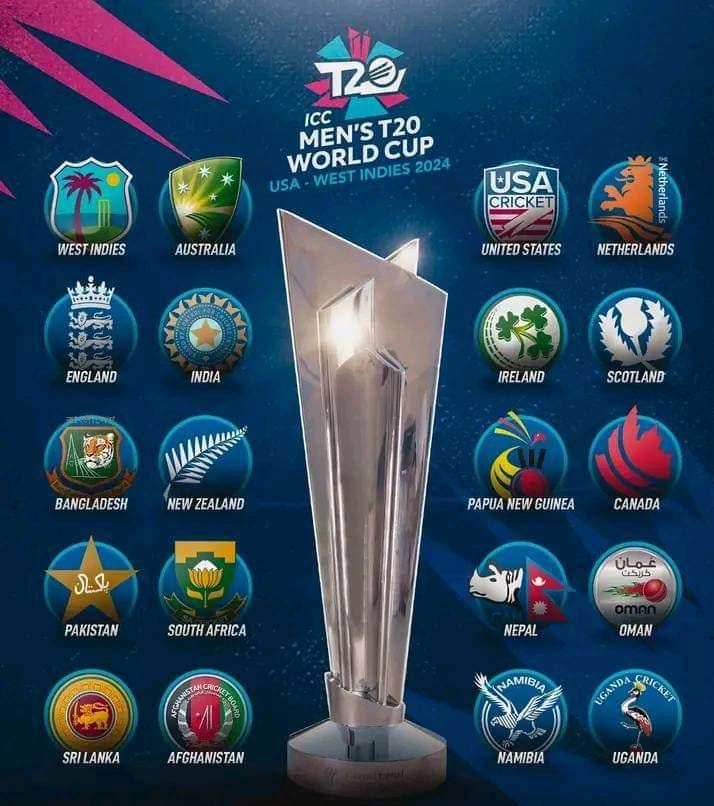Why the T20 World Cup matters
With cricket being considered as a "dying sport" by many, the T20 World Cup acts as a ray of hope
Introduction
As the ICC T20 Men’s World Cup 2024 began today, I wanted to take a short break from the Failed States series, which I will continue in the next post!
Today, we will talk a little bit about the World Cup, cricket’s status as a dying sport and predictions for the future.
Brief history
Cricket originated in the late 16th century in England. For about 100 years, cricket remained exclusively a children’s sport. Cricket became popular amongst adults in the late 17th century, when aristocrats and nobles founded their teams to reap monetary rewards (obtained from betting) when their teams won. Soon enough, country cricket was first established in England in 1709.
From here, cricket was slowly formalised into a proper sport. The ‘Laws of Cricket’ were first drafted in 1744 and key amendments were made in 1774 when rules such as lbw were added.
First-class cricket began in 1772, and with this came scorecards! Broadhalfpenny Down in Hampshire became the first cricket ground to host a first-class match. Country cricket in England became official when Sussex, the first country club, was created in 1839.
In the 19th century, cricket spread like wildfire throughout British colonies. In 1844, the first international cricket match was held between the US and Canada in New York. Soon, Australia and South Africa began sending out teams to play each other and England at international venues. To coordinate cricket matches globally, the Imperial Cricket Conference (which we today know as the International Cricket Council or ICC) was founded between these 3 countries in 1909.
The scope of the ICC was broadened in 1975 and 2007 when they hosted the first ODI World Cup in England and the first T20 World Cup in South Africa respectively. Moreover, the first Champions Trophy was hosted in 1998 in Bangladesh. Although there are only 12 test-playing members of the ICC, other teams can participate in these limited-overs tournaments by doing well in qualifiers and, once qualified, performing well in previous editions.
More recently, the ICC has added one more tournament to their stockpile. The first World Test Championship was held between 2019 to 2021. Cricket will also be played in the Olympics in Los Angeles from 2028!
T20 World Cup 2024
You might wonder why I’m saying that this T20 World Cup is special. This is a very valid question as it’s not even the most popular cricket tournament.
The ICC ODI Men’s World Cup is the 3rd most-watched sports tournament, only behind the FIFA World Cup and the Tour de France. As of 2023, the ODI World Cup has a massive 2.6 billion viewers. The 2023 ODI World Cup in India got 518 million views on TV.
So shouldn’t the ODI World Cup be the primary propagator of cricket around the world? Well, contrary to popular belief, it’s very much not. That title undoubtedly goes to the T20 World Cup, especially the current edition.
This boils down to one simple statistic: the 2023 ODI World Cup had 10 participant countries while the 2024 T20 World Cup has 20, which is twice as many. Thus, the T20 World Cup 2024 includes the most number of countries of any tournament in the history of the game!
Dying sport
The significance of this fact can be understood by looking at some cricket statistics, and why many people believe cricket to be a dying sport.
Proponents of this opinion state that cricket is a highly localised sport. The ICC itself gives us one striking evidence for this fact. There are a mere 12 test-playing members, which is painfully less. And consider this, 5 of those nations are in South Asia: India, Pakistan, Bangladesh, Sri Lanka and Afghanistan. None of the 12 are from Africa, and the West Indies is the only one in the Americas. Thus, there is truth to the fact that cricket is pretty localised.
We can’t discuss localisation without talking about who watches cricket. Out of the 2.6 billion viewers that watch cricket, 1.1 billion come from just one country: India. The second most cricket-crazy country, Pakistan, only has about 133 million cricket watchers. These numbers tell us that about 78% of Indians and 55% of Pakistanis watch cricket. If it wasn’t clear to you before, it should be now: cricket viewership is synonymous with India.
This imbalance of interest is also reflected in the wealth of cricket boards. The Board of Control of Cricket in India (BCCI) has a net worth of 2.25 billion USD. Cricket Australia (CA), the second richest board, has a net worth of only 79 million USD.
This is the precise reason why we hear cricket is a dying sport. Initially being popular in all corners of the British Empire, including the Americas and Africa, today it’s only really relevant in South Asia. But, the T20 World Cup is a step in the right direction.
Conclusion - Cricket around the world
The novel advent of franchise cricket and T20 Internationals has led to so many more countries being represented on the biggest stages of the game. Countries such as Papua New Guinea are getting the chance to take on established test-playing teams such as the West Indies.
To host the T20 World Cup, the US has built the 34,000-seat Nassau County International Cricket Stadium in New York. This wasn’t cheap, as it cost them 30 million USD!
What this shows is that other countries around the world want to take cricket seriously. Other countries want to take part in this great sport, and T20 is the best format to do so.
Test is an extremely difficult format to play. Playing 90 overs per day for five days is, of course, very exhausting. Moreover, you need to be a high-quality player to play a test match due to the demanding nature of the format. And with only 12 test-playing members, other countries simply cannot play test professionally. Furthermore, playing an ODI World Cup is also difficult as at least 8 of the spots are blocked by irreplaceable teams. That leaves us with one option: T20.
T20 is perfect to allow as many players to play as possible. Franchise cricket has made it so that making money off of leagues everywhere (IPL, SA20, MLC, etc) is possible. Thus, we are at a stage where T20 gives countries opportunity and legitimacy while also turning profits for the sponsors.
Wealthy Arab countries also benefit a lot from T20. The UAE and Oman both have a team in the 2024 T20 World Cup. Cricket can play a part in the diversification of the Arab countries' economies away from oil, which will one day run out.
I certainly believe T20 is going to be critical in propagating cricket around the world, which is great in spreading this beautiful game cherished by so many Indians. Yes, this may lead to new viewers appreciating Test cricket (or the “real” cricket) less. But, that’s what everyone said when the ODI World Cup was first introduced. I think that as the times are evolving, so must we.
If T20 is allowing new countries to play in ICC tournaments, so be it!
Donations
As always, remember to check out our selected NGO: MyZeroGravity. If you wish to donate to MyZeroGravity and help their noble cause, you can use the payments page we have set up: donate to MyZeroGravity!












